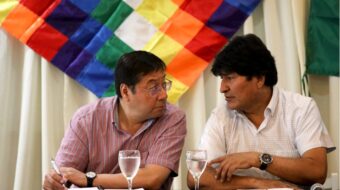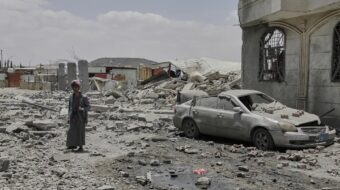The Obama administration has yet to be heard from on Colombia. The Colombia military alliance remains strong, as indicated by U.S. use of bases there to replace Ecuador’s Manta air base from which U.S. troops and planes were expelled.
U.S. trade representative Ron Kirk is reviewing the proposed Colombia Free Trade Agreement, rejected by Barack Obama during his presidential campaign. Kirk cited a “very productive” meeting with Colombian President Alavaro Uribe at the recent Summit of the Americas. The objective is “finalizing free trade agreements with [Colombia and Panama],” Kirk told reporters. “There are obstacles,” said Representative Charles Rangel, Chair of the House Ways and Means Committee, “but I’m confident under Obama’s leadership they will be overcome.” (Mercopress.com)
U.S. businesses provide Colombia with 26.8 per cent of its imports and receive 35.8 per cent of its exports. Foreign direct investment in Colombia, the United States leading the pack, increased five-fold after 1990. Colombia is “the best-run country in Latin America,” according to moneymorning.com.
There is, however, another story. New data are available to policymakers confronting the issue of U.S. complicity with a problem regime.
The Colombian Information Bureau on Human Rights and Displacement last week reported on displacement from homes, land and workplaces during 2008 (see codhes.org). Yearly totals are 221,638 in 2006, 305,638 in 2007, and last year 380,863, representing 76,120 families.
In all, 4,628,882 people ― 925,776 families ― have been displaced since 1985. The peak year was 2002. Peace dialogues with leftist insurgents ended that year and 412,553 persons were displaced. Since then, the Uribe government has expanded troop numbers and intensified military operations against guerrilla insurgents. Military spending rose to 6.5 percent of Colombia’s GDP. Peasants became both military objectives and vulnerable bystanders.
The catalogue of abuses includes mass displacements, 37 instances last year of mass killings, sexual violence directed at women, forced recruitment, destruction of houses and community buildings, and aerial fumigations causing food shortages. Indigenous people are targeted. The Inter-American Commission on Human Rights reported last year that 1,200 indigenous people were assassinated during the first six years of Uribe’s presidency.
Fear and a sense of precariousness prevail. Since 2000, 385,000 rural families have given up 13.8 million acres of land, or 10.8 percent of the country’s agricultural land. Confiscated land has been absorbed into large tracts for mines, ranches and monoculture plantations, many dedicated to bio-fuel production.
The process was on display in La Cooperativa, a village in the Macarena region. Independent journalist Gary Leech visited there, studying the operation of nine-year old Plan Colombia (see colombiajournal.org). That anti-insurgent, anti-drug operation bolstered by $5.5 billion in U.S. aid relies upon military and police force. In a strategy called “Democratic Security,” the Uribe government engrafted social and economic initiatives.
The army arrived in La Cooperativa, guerrillas of the Revolutionary Armed Forces of Colombia (FARC) left, roads were fixed, computers appeared in the school, and farm machinery materialized. The army, working in tandem with rightwing paramilitaries, accused inhabitants of FARC sympathies. The village population fell from 400 to 70, and that of nearby El Tigre, from 200 to 12.
British parliamentarians and labor activists visiting Colombia last month told reporters, “We are shocked.” The delegation included Canadian unionists, U.S. Representative Jim McGovern (D-Mass.), and United Steelworker officers Adam Lee, Frederick Redmond and Mark Rowlinson.
A spokesperson for the group cited “fathers, mothers, siblings, and children assassinated, displaced families, unionists threatened, intimidated and killed, and innocent peasants murdered and dressed up as guerrillas.” The latter refers to the recent “false positives” scandal. Soldiers killed 1,200 people to inflate body counts following guerrilla encounters.
On leaving, the delegation stated, “We have no doubts on the evidence given that the Colombian government of Alvaro Uribe and the security forces are complicit in human rights crimes. We are convinced also that the murderous activities of the paramilitary forces are condoned and actively supported by the government and army.” They called for “an immediate end to all military aid and support to the Colombian Government.”
The findings are consistent with last year’s Amnesty International report that indicated “At least 1,340 civilians were killed or forcibly disappeared in the 12-month period ending in June 2007.” According to the AFL-CIO Solidarity Center, 4,000 trade unionists have been killed in the past 20 years.
Murders continue. Recent victims include:
Eder Enrique Sierra Carranza, student, Rioacha, March 9
Jorge Andrés Isaza Velázquez, lawyer, Medellin, March 12
Luis Arbey Díaz Rubiano, community leader, La Macarena, March 14
Hernán Polo Barrera, teachers’ union leader, Montería (sixth unionist murdered, 2009), April 4,
Ten persons, Arauca, Saravena and Tame municipalities, March 27-April 1
Claudia Fernanda Ramos Camacho, teacher, Alto Naya, April 19.
Edgar Martinez Ruiz, agricultural cooperative leader, San Pablo, Bolivar, April 22,
J. Everardo Aguilar, journalist, El Patio, April 25.
Meanwhile, according to the United Nations, 18 per cent of all Colombians live on less than $2 a day. In 2006 the richest 10 per cent lived on nearly 47 per cent of the country’s income.









